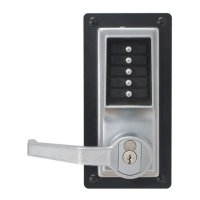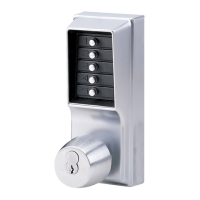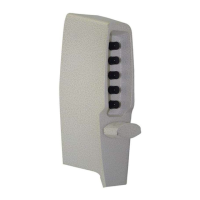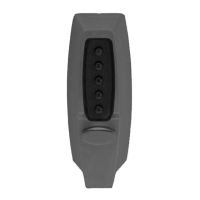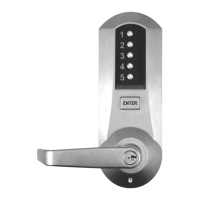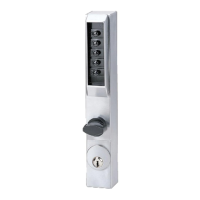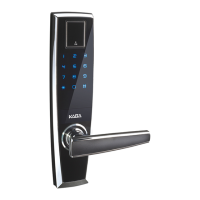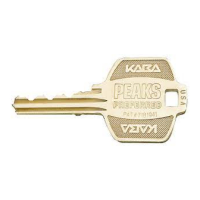This step is very important, as it will
keep the lock from being inadvertently
forced out of timing.
1. Locate the drive pins/actuators found in
the key override slot of the outside
lever.
Note: These vary depending on the key
override selected. For Best, Corbin, or
Sargent, use figure 3-1, for Schlage, use
figure 3-2, and for Medeco/ASSA/Yale use
figure 3-3.
2. Notice the rear of the cylinder that will
be installed. The profile and receiver
area on the rear of that cylinder should
be able to receive the pins/actuators
found inside the lever.
3. The drive pins/actuators must be
aligned to easily receive the cylinder
when installed. The lever does not need
to be turned partially or otherwise to
insert the cylinder. If this is done, it will
cause the drive shaft to be turned and
the timing will be off.
4. If the drive pins/actuators will not align,
use a flat blade screwdriver or needle
nose pliers to turn the pins/actuator
approximately 180
°
. Then repeat Step 3.
Note: Rotate tailpiece to stop position
(For left hand locks, rotate counter clock-
wise; for right hand locks rotate clockwise)
5. Once the cylinder is inserted and locked
into place, rotate the key and the tail-
piece should rotate. If so, release and
remove the key. If not, repeat Step 4.
6. Turn the outside lever. The tailpiece
should not move. If it does, the timing is
off. Remove the cylinder and repeat
Step 4.
7. Enter the combination, assuring it
works as intended. The tailpiece should
rotate.
Este paso es muy importante, pues
guardará la cerradura inadvertidamente de
ser forzado fuera de la sincronización.
1. Localice los pernos de impulsión/los
actuadores encontrados en la ranura
dominante de la invalidación de la
palanca exterior.
Nota: Éstos varían dependiendo de la
invalidación de llave seleccionada. Para el
mejor, Corbin, o Sargent, utiliza el cuadro
3-1, para Schlage, el cuadro 3-2 del uso, y
para el cuadro 3-3 del uso de
Medeco/ASSA/Yale.
2. Note la parte posterior del cilindro que
será instalado. El perfil y el área del
receptor en la parte posterior de ese
cilindro deben poder recibir los
pernos/los actuadores encontrados den-
tro de la palanca.
3. Les clavettes/déclencheurs doivent être
alignés pour recevoir facilement le cylin-
dre une fois installés. Le levier n'a pas
besoin d'être tourné partiellement ou
d'insérer autrement le cylindre. Si ceci
est fait, il causera l'arbre d'entraînement
d'être tourné et la synchronisation sera
éteinte.
4. Si los pernos de impulsión/los actuadores
no alinean, utilice un destornillador del
negro plano o los alicates de nariz de
aguja para dar vuelta a los pernos/actu-
ador aproximadamente 180°. Entonces
repita el paso 3.
Nota: El tubo de cola Rotación hacia la
posición de parada (para cerraduras de la
mano izquierda, gire hacia la izquierda,
porque la mano derecha cerraduras girar
en sentido horario)
5. Una vez que el cilindro se inserta y se
traba en lugar, gire la llave y el cierre
debe contraer a ras. Si es así lance y
quite la llave. Si no, repita el paso 4.
6. Gire la palanca exterior. El tubo de
desagüe no debe moverse. Si lo hace, el
tiempo está desactivada. Retire el cilin-
dro y repita el Paso 4.
7. Introduzca la combinación, asegurando
que funciona según lo previsto. La pes-
taña debe girar.
3
Instalación del cilindro
dominante de la invalidación
Installing the key
override cylinder
8

